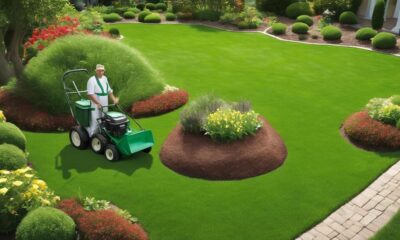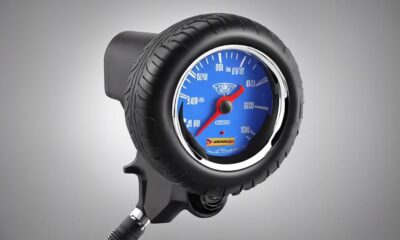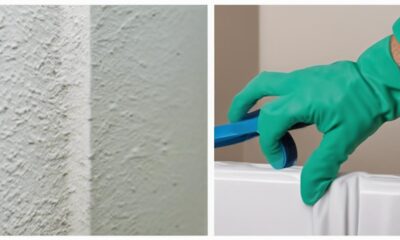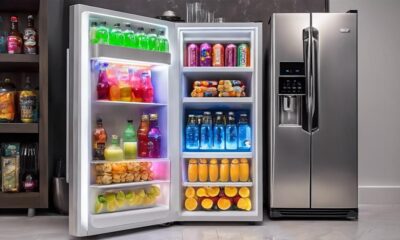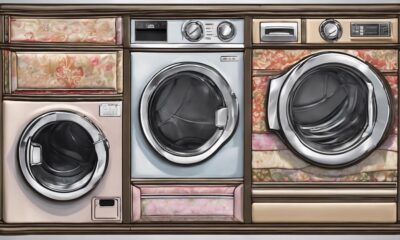Appliances
Paint a Mug
2025

Have you ever been given a plain white mug as a gift and wanted to add your own personal touch with a custom design?
Well, painting a mug is a fun and creative way to add a personal touch to an everyday item. Whether you want to make a unique gift for a friend or simply enjoy a relaxing crafting activity, painting a mug can be a rewarding experience.
But before you start, there are some important steps to consider that will ensure your painted mug turns out just the way you envision.
Key Takeaways
- Select a mug with durability, smooth texture, and a comfortable handle for a better painting experience.
- Choose the right type of paint, such as acrylic, porcelain, oil-based paint pens, or glass paint, based on durability and visual appeal.
- Plan and sketch out the design, considering color palette, inspiration, and artistic styles and techniques.
- Care for the painted mug by properly curing it, applying sealant, hand-washing with gentle detergent, and avoiding high heat and stacking. Showcase the mug in a well-lit area, highlighting its unique features and personalizing the display.
Selecting the Right Mug
When choosing the perfect mug for painting, we prioritize durability, smooth texture, and a comfortable handle. The durability ensures that the design will last through numerous washes, while a smooth texture provides an ideal canvas for intricate designs. A comfortable handle isn't only essential for practical use but also contributes to the overall aesthetic appeal of the finished piece.
As we delve into mug selection, design inspiration plays a pivotal role. We seek mugs with a blank canvas that sparks creativity, whether it's a simple, elegant design or a unique shape that inspires unconventional patterns.
Surface preparation is crucial when it comes to mug painting. We look for mugs with a smooth, clean surface, free from any scratches or imperfections that could interfere with the design. This initial step sets the stage for a flawless finished product.
Design challenges often arise when selecting mugs with irregular shapes or non-uniform surfaces. These mugs require thoughtful consideration and strategic design placement to ensure a cohesive and polished final result.
Our keen eye for mug selection is driven by our passion for creating visually striking, durable pieces that stand the test of time.
Preparing the Surface
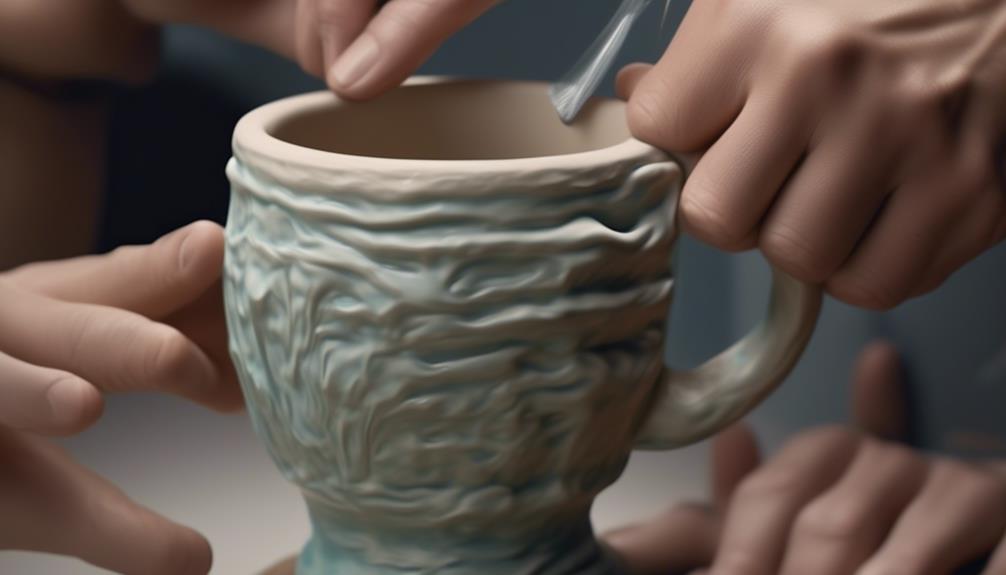
To ensure a flawless painting surface, we meticulously clean and thoroughly dry the selected mug before applying any design. Here's how we prepare the surface:
- Surface cleaning: We start by cleaning the mug with warm soapy water to remove any dirt, oils, or residues that could affect the paint's adhesion.
- Drying process: After cleaning, we dry the mug with a lint-free cloth to ensure there's no moisture left on the surface, which could cause the paint to bubble or peel.
- Sanding technique: Next, we lightly sand the surface of the mug with fine-grit sandpaper to create a slightly rough texture for better paint adherence without scratching the mug.
- Primer application: Once sanded, we apply a thin layer of ceramic primer to the mug, which helps the paint bond to the surface and provides a smooth base for the design application.
Choosing the Right Paint

When it comes to painting a mug, choosing the right paint is crucial. We'll explore different paint types, surface preparation, and application techniques to ensure a successful outcome.
Understanding the nuances of each point will help us achieve a beautifully painted mug that lasts.
Paint Types
Choosing the right paint for your mug painting project is essential for achieving a professional and long-lasting finish. When it comes to paint types, there are several factors to consider:
- Brush types: Selecting the right brush is crucial for achieving the desired texture and finish. Different brush types, such as flat, round, or angled, can produce varying effects on the mug's surface.
- Application methods: Understanding the best application method for the chosen paint type is important. Whether it's stippling, layering, or using a sponge, the application technique can significantly impact the final look of the painted mug.
- Surface preparation: Properly preparing the mug's surface, whether it's cleaning, sanding, or priming, can ensure better paint adhesion and longevity.
- Drying time: Be mindful of the paint's drying time to avoid smudges or imperfections. Allow adequate drying time between coats for a flawless finish.
Surface Preparation
In preparing the mug's surface for painting, it's crucial to carefully consider the type of paint that will best adhere to the material and ensure a durable and visually appealing finish.
Surface cleaning is essential to remove any dirt, grease, or residues that could hinder paint adhesion. After cleaning, surface sanding helps create a slightly rough texture, promoting better paint adhesion.
Once the surface is prepped, primer application is key, especially for materials like ceramic or porcelain. The primer enhances paint adhesion and provides a uniform base for the paint to adhere to.
When choosing the right paint, consider factors such as heat resistance and dishwasher safety, particularly for mugs.
With proper surface preparation and the right paint, you'll achieve a professional and long-lasting finish on your painted mug.
Application Techniques
To achieve a professional and long-lasting finish on our painted mug, selecting the right paint is critical for ensuring durability and visual appeal. When choosing the paint for our mug, we need to consider a few key factors:
- Acrylic Paint: This versatile paint adheres well to ceramic surfaces and offers a wide range of colors for blending and layering techniques.
- Porcelain Paint: Specifically designed for ceramic surfaces, this paint provides a durable and glossy finish, perfect for intricate designs and detailing.
- Oil-Based Paint Pens: These pens offer precision and control for detailed work, allowing for intricate designs and blending colors seamlessly.
- Glass Paint: While primarily for glass, some types of glass paint can also be used on ceramic surfaces, providing a translucent effect and enabling layering techniques for unique visual effects.
Selecting the right paint will allow us to unleash our creativity and achieve a stunning painted mug.
Gathering Your Supplies

After gathering the necessary supplies, we can begin the process of painting a mug. Gathering materials is the first step in this creative endeavor. To set the scene for a successful mug painting session, we need to assemble the following items:
- a plain ceramic mug
- acrylic paint or ceramic paint
- paintbrushes of various sizes
- painter's tape
- a palette or disposable plate for mixing colors
- paper towels
- a sealing varnish (if using acrylic paint)
It's essential to work in a well-ventilated area and protect the work surface with newspaper or a drop cloth.
The choice of ceramic mug is crucial, as the paint needs to adhere properly. When selecting paint, ensure it's suitable for ceramic surfaces and, if desired, dishwasher-safe. The variety of paintbrush sizes allows for intricate detailing and broad brushstrokes. Painter's tape can be used to create clean lines and geometric designs. Paper towels are handy for wiping brushes or correcting mistakes. The sealing varnish provides a protective finish for acrylic-painted mugs.
With these supplies at hand, we're ready to embark on the exciting journey of painting a personalized mug.
Planning Your Design

So, when it comes to planning your design for your mug, we need to start by sketching out our ideas. This will help us visualize the final product and make any necessary adjustments.
Additionally, we'll want to choose a color palette that complements our design and adds a pop of personality to our mug.
Sketching Your Ideas
How can we effectively translate our ideas onto paper as we plan the design for our mug painting project? Sketching our ideas is a crucial step in the creative process, allowing us to visualize and refine our design concepts before applying them to the mug. Here are some essential steps to consider:
- Creative Inspiration: Seek inspiration from various sources such as nature, art, or personal experiences to fuel your creative ideas.
- Artistic Expression: Explore different artistic styles and techniques to express your unique vision on paper.
- Design Brainstorming: Engage in brainstorming sessions to generate diverse design concepts and gather multiple perspectives.
- Concept Development: Refine your initial ideas through iterative sketching, gradually shaping and evolving the design concept.
Choosing Color Palette
When planning our design, we carefully select a color palette that harmonizes with our vision and enhances the visual impact of the mug painting. Exploring color harmony is essential in this process.
We aim to create a palette that not only reflects our personal style but also resonates with the purpose of the mug. Customizing color combinations allows us to evoke specific emotions or convey particular themes. For instance, warm and vibrant colors can infuse energy and joy into the design, while cooler tones may evoke a sense of calm and tranquility.
We consider the interplay of colors and their effects on the overall composition, ensuring that they complement each other to create an aesthetically pleasing and cohesive visual narrative. Each color choice contributes to the mug's overall appeal, making the design truly captivating.
Applying the Base Coat
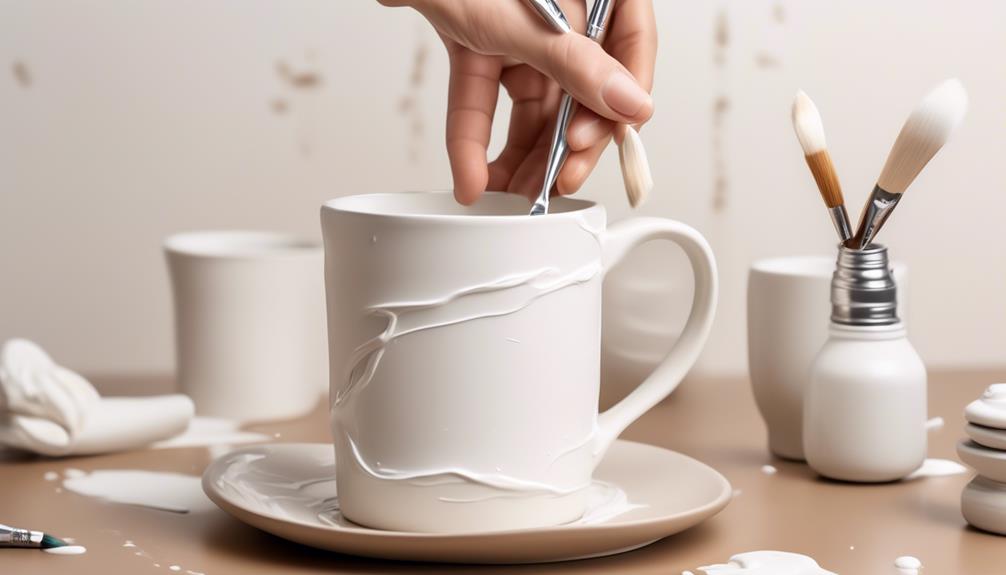
We begin by applying a smooth and even base coat to the mug to provide a solid foundation for the design. This step is crucial to ensure that the colors appear vibrant and adhere well to the surface. Here's how to apply the base coat effectively:
- Preparation: Clean the mug thoroughly and ensure it's completely dry before starting the base coat application.
- Layering Techniques: Apply the base coat using smooth, even brush strokes, ensuring full coverage while avoiding drips or clumps.
- Color Blending: If you're blending multiple colors for the base coat, carefully blend the edges to create a seamless transition between colors.
- Drying Time and Surface Texture: Allow the base coat to dry thoroughly according to the paint manufacturer's instructions. Check for any uneven texture and sand lightly if needed to achieve a perfectly smooth surface for the next steps.
Adding Details and Accents

Alright, let's talk about adding those final touches that will really make your mug stand out.
We'll cover different brush stroke techniques that can add depth and texture to your design.
We'll also discuss how to choose color schemes that complement each other.
These details and accents are what'll take your painted mug from ordinary to extraordinary.
Brush Stroke Techniques
To enhance the mug's design, employ various brush stroke techniques to add intricate details and striking accents. Here are some techniques to help you achieve a professional finish:
- Dry Brushing: Lightly load the brush with paint and then remove most of it on a paper towel before gently sweeping it over the surface. This technique adds a delicate, textured look to your design.
- Sgraffito: Use a sharp tool to scratch through a top layer of paint to reveal the color underneath. This creates intricate patterns and adds visual interest to your mug.
- Stippling: Dab the brush repeatedly onto the surface to create a pattern of tiny dots. This technique is great for adding texture and depth to your design.
- Linework: Use a fine brush to create detailed lines and intricate designs, adding a professional touch to your mug.
Choosing Color Schemes
When adding details and accents to your painted mug, consider the color scheme carefully to achieve a cohesive and visually appealing design. Color psychology plays a crucial role in evoking specific emotions and moods. Experiment with mixing techniques to create custom shades that resonate with your personal style.
Trendy combinations such as pastel gradients or monochromatic palettes can add a modern touch to your design. Bold contrasts, like pairing complementary colors or using a pop of neon against a neutral background, can make your mug stand out. Understanding color harmony and balance is essential for creating a visually striking mug.
Remember to take into account the overall aesthetic you want to achieve and the recipient's preferences when selecting the color scheme.
Curing the Paint

After applying the paint to the mug, the next step is to cure it to ensure its durability and longevity. This process is crucial for achieving a professional and long-lasting finish. Here's how to effectively cure the paint on your mug:
- Drying Process: Once the paint is applied, allow the mug to air dry for at least 24 hours. This initial drying process sets the foundation for the curing phase.
- Temperature Control: Place the painted mug in a cold oven and then set the temperature to 350°F (175°C). It's important to start with a cold oven to prevent cracking due to sudden temperature changes.
- Time Management: Allow the mug to cure in the oven for 30 minutes once it reaches 350°F (175°C). This step is essential for the paint to properly adhere to the mug's surface.
- Patience and Precision: After the 30 minutes are up, turn off the oven and let the mug cool down inside before removing it. Rushing this step may compromise the paint's adherence.
Enhancing Durability With Sealant
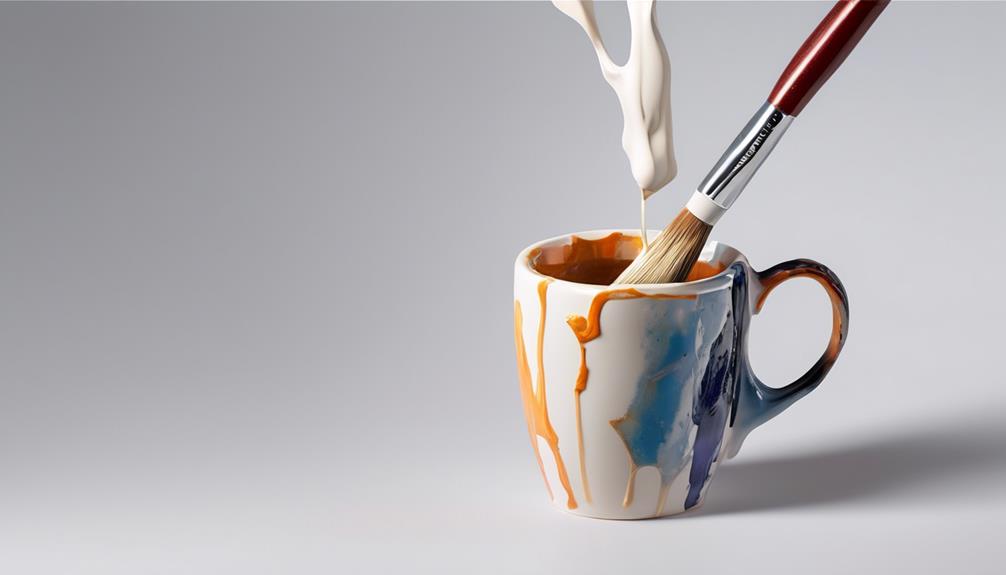
Using a high-quality sealant can significantly enhance the durability and longevity of the painted design on your mug. Sealant application is a crucial step in ensuring that your carefully crafted design withstands the test of time and daily use. When applying the sealant, it's essential to use a soft brush to evenly coat the entire painted surface. This ensures that the sealant provides comprehensive protection against wear and tear.
The sealant acts as a shield, offering longevity and protection to the painted mug. It creates a barrier that guards against scratches, fading, and moisture damage. This not only preserves the aesthetic appeal of the mug but also maintains the integrity of the design.
Additionally, the sealant makes the surface easier to clean, as it prevents the paint from chipping or peeling off during washing.
Caring for Your Painted Mug

To maintain the vibrancy and longevity of your painted mug, regular hand-washing with a gentle detergent is recommended. This simple care routine can significantly prolong the life of your artwork.
Additionally, consider the following tips for long term care:
- Dishwasher Safe: If your painted mug is labeled as dishwasher safe, you can safely place it in the dishwasher. However, using the dishwasher too frequently may cause the colors to fade over time.
- Avoiding Chipping: To prevent chipping, avoid stacking other items inside the mug and handle it with care. It's also advisable to store the mug away from other heavy or sharp objects.
- Microwave Use: While some painted mugs are microwave safe, it's best to avoid prolonged exposure to high heat. This will help maintain the integrity of the paint and prevent any potential damage.
- Regular Inspection: Periodically inspect the painted surface for any signs of wear and tear. If you notice any chipping or fading, it's best to discontinue microwave and dishwasher use to preserve the artwork.
Taking these simple precautions will ensure that your painted mug remains a cherished item for years to come.
Showcasing Your Masterpiece

Let's display your painted mug in a well-lit area to accentuate the intricate details and vibrant colors of your masterpiece. Showcasing your creation is just as important as the painting process itself. One effective technique is to place the mug on a rotating display stand, allowing viewers to appreciate all angles of your design. This method works exceptionally well for mugs with 360-degree patterns or elaborate designs that deserve to be seen from every perspective.
Another showcasing technique involves creating a themed display that complements the mug's design. For example, if your mug features floral patterns, consider placing it alongside fresh flowers or in a garden-themed setting to enhance the overall visual impact. The key is to add a personal touch to the display that resonates with the mug's design, creating a harmonious and visually appealing presentation.
When showcasing your masterpiece, consider the lighting carefully. Soft, natural light can bring out the colors and details, while avoiding harsh glares or shadows that may detract from the mug's beauty. Ultimately, the goal is to showcase your painted mug in a way that highlights its unique features and reflects your creativity and skill.
Can I Use the Same Paint for Mugs as I Would for a Pancake Griddle?
Yes, you can use the same paint for mugs as you would for a pancake griddle. Just make sure the paint is heat-resistant and safe for food. When cooking pancakes on griddle temperature can get quite high, so it’s important to choose the right type of paint to avoid any potential health hazards.
Frequently Asked Questions
Can I Use Regular Acrylic Paint for My Mug or Do I Need a Special Type of Paint?
Regular acrylic paint may not be the best choice for your mug. For paint durability, it's best to use a special type of paint designed for ceramics and glass. These paints are formulated to withstand frequent washing and heat exposure.
When it comes to mug design techniques, using the right paint will ensure your designs stay vibrant and long-lasting. Consider investing in specialized ceramic or glass paint for the best results.
How Long Should I Wait Before Using My Painted Mug After Applying the Sealant?
After applying the sealant to our painted mug, we should let it dry for at least 24 hours to ensure proper adhesion and durability. This waiting period allows the sealant to fully cure and become heat resistant, making the mug safe for use with hot beverages.
Additionally, it enhances the dishwasher safety of the painted design. Ensuring adequate drying time is crucial for maximizing the longevity and quality of our personalized mugs.
Are There Any Specific Care Instructions for Washing My Painted Mug?
When washing your painted mug, it's important to follow specific care instructions. If it's labeled as dishwasher safe, feel free to use the dishwasher. However, if it's recommended for hand washing only, it's best to avoid the dishwasher.
To maintain the paint and sealant, use gentle detergent and avoid abrasive scrubbing. Additionally, ensure the mug is heat-resistant to prevent damage during washing.
Can I Use a Hairdryer to Speed up the Curing Process of the Paint on My Mug?
Using a hairdryer to speed up the curing process of paint on a mug can be effective, but it's important to use a low heat setting to avoid damaging the paint or the mug.
Alternatively, air-drying the mug allows for a more gentle and even curing process, although it takes longer.
Both methods have their pros and cons, and the choice depends on the level of patience and care one is willing to invest.
What Are Some Creative Ways to Display or Showcase My Painted Mug?
When it comes to mug display, we've got some creative ideas!
One option is to arrange painted mugs on a floating shelf for a sleek, modern look.
Another idea is to create a DIY mug tree or stand using wood or metal.
For gift ideas, consider pairing a painted mug with a small plant, succulent, or a package of gourmet hot cocoa mix.
Get creative with designs and enjoy some fun DIY projects!
Conclusion
So, now that you've painted your mug and put so much effort into making it look amazing, it's time to enjoy your favorite hot beverage in it.
Just be sure to hand wash it gently and avoid using it in the microwave or dishwasher.
After all, what's the point of painting a mug if you can't even use it, right?
But hey, at least it looks pretty sitting on your shelf!
Cheers to your artistic skills!
- About the Author
- Latest Posts
Introducing Ron, the home decor aficionado at ByRetreat, whose passion for creating beautiful and inviting spaces is at the heart of his work. With his deep knowledge of home decor and his innate sense of style, Ron brings a wealth of expertise and a keen eye for detail to the ByRetreat team.
Ron’s love for home decor goes beyond aesthetics; he understands that our surroundings play a significant role in our overall well-being and productivity. With this in mind, Ron is dedicated to transforming remote workspaces into havens of comfort, functionality, and beauty.
Garage Door Opener
Choosing the Right Size Battery for Your Garage Door Opener
Find out why selecting the perfect battery size for your garage door opener is crucial for avoiding disruptions and ensuring smooth operation.

We’ve all experienced it – 70% of garage door opener malfunctions are caused by battery problems. Choosing the correct size battery is crucial for smooth operation.
But how do you know which battery is the perfect fit for your opener? Let's shed light on this essential aspect to keep your garage running smoothly and avoid unexpected disruptions.
Key Takeaways
- Consider manufacturer's voltage requirements for optimal performance.
- Choose the correct battery size for longer opener lifespan.
- Rechargeable batteries offer cost-effectiveness and consistent power.
- Adhere to manufacturer's recommendations for efficient operation.
Factors to Consider When Choosing Battery Size
When selecting the appropriate battery size for your garage door opener, it's crucial to carefully consider the voltage requirements specified by the manufacturer. Adhering to the manufacturer's recommendations ensures that the battery size is compatible with your garage door opener, providing the necessary power source for optimal performance. Choosing the correct battery size not only allows for efficient operation but also contributes to a longer lifespan for your garage door opener.
Opting for a rechargeable battery can be a practical choice, offering the advantage of being reusable and environmentally friendly. Rechargeable batteries provide a cost-effective solution in the long run, as they can be recharged multiple times before needing replacement. Additionally, they often have a higher capacity compared to disposable batteries, ensuring a consistent power supply to your garage door opener.
Types of Batteries for Garage Openers

For selecting the appropriate battery type for garage door openers, consideration of lithium, alkaline, and rechargeable options is essential based on their power characteristics and longevity.
When it comes to garage door opener batteries, here are the options to consider:
- Lithium Batteries: Known for their long-lasting power and reliability, lithium batteries are commonly used in garage door opener remote controls.
- Alkaline Batteries: Offering a non-rechargeable but reliable power source, alkaline batteries are another viable option for garage door openers.
- Rechargeable Batteries: Rechargeable options like nickel-cadmium (NiCd) and lithium-ion (Li-ion) provide sustainability and cost-effectiveness for long-term use in garage door openers.
- Manufacturer's Recommendations: Battery size and type depend on the specific brand and model of the garage door opener, so it's crucial to check the manufacturer's recommendations to ensure optimal performance and prevent malfunctions.
Popular Battery Brands for Openers
Among the array of battery brands available for garage door openers, Duracell stands out for its reputation of delivering enduring power and exceptional performance.
Known for their long-lasting power and reliable performance, Energizer batteries are a popular choice for various garage door opener models.
Panasonic batteries are recognized for their durability, reliability, and high energy output, making them a preferred option for many users.
Rayovac offers value for money with its combination of long-lasting performance and reliability, making it a top contender in the market of garage door opener batteries.
Eveready also provides dependable options for garage door opener batteries, ensuring consistent power and performance.
When choosing the right battery for your garage door opener, considering these popular brands can help you find the optimal balance between longevity, reliability, and performance for your specific needs.
How to Replace Garage Door Opener Battery

Having identified the specific battery type required for your garage door opener, the next step is to open the remote control cover correctly to access the battery compartment for replacement.
When replacing the battery for your garage door opener, follow these steps:
- Open the Cover: Gently slide the cover of the remote control in the direction indicated to reveal the battery compartment.
- Remove the Old Battery: Carefully take out the old battery by pushing it gently from the sides to release it from the connectors.
- Insert the New Battery: Place the new battery in the compartment, ensuring the correct orientation as per the markings inside.
- Close the Cover: Once the new battery is securely in place, slide the cover back onto the remote control until it clicks shut.
Troubleshooting Tips for Battery Issues
To troubleshoot battery issues with your garage door opener, we recommend conducting a thorough inspection of the battery compartment and connections. Start by checking the brand and model of your garage door opener remote to determine the correct battery type needed for replacement. It's crucial to use the specific battery number designated by the manufacturer to prevent compatibility problems with your garage door opener.
If necessary, refer to the owner's manual or open the transmitter to identify the exact battery required for your remote control. Pay attention to any colored smart buttons on the remote, such as yellow ones for Security+ 2.0 models, which may indicate the particular battery type needed. Always ensure the proper functioning of your garage door opener remote by using the right battery number and avoiding substitutions to prevent any potential damage.
Frequently Asked Questions
What Size Battery Does My Garage Door Opener Take?
We must ascertain the specific battery size required by your garage door opener for optimal performance.
It's crucial to identify the manufacturer-specified battery number and the type indicated by the colored smart buttons on the remote control.
Accessing the battery compartment through the proper opening of the remote control cover is essential for replacement.
Ensuring the correct battery size will guarantee seamless operation of your garage door opener.
What Battery Is Best for Garage Door Opener?
We've found that longevity is crucial when selecting the best battery for a garage door opener, with lithium batteries lasting approximately 5 years.
It's vital to match the specific battery type recommended for your transmitter to avoid compatibility issues.
Do Garage Door Openers Need Special Batteries?
Yes, garage door openers do require special batteries. These batteries, like 3-volt lithium or 12-volt options, are crucial for reliable remote operation in various settings. Having the correct battery size is essential to prevent malfunctions and ensure smooth garage door operation.
Additionally, certain keypads and remote controls may need 9-volt batteries for backup power in keyless entry systems. Selecting the right size and type of battery is vital for consistent functionality.
What Battery Do I Need for Liftmaster Garage Door Opener?
We need a CR2016 or CR2032 3-volt lithium battery for our LiftMaster garage door opener.
It's crucial to check the model specifications for the correct battery type. Proper maintenance and timely battery replacement are essential for smooth operation.
Make sure to have the right battery on hand to avoid any disruptions in functionality.
Conclusion
In conclusion, selecting the appropriate battery size for your garage door opener is imperative for optimal performance. By considering factors such as capacity, lifespan, and voltage requirements, you can ensure smooth operation.
Choosing reputable brands like Duracell or Energizer and performing regular maintenance will further enhance reliability. Remember, a well-chosen battery can make all the difference between seamless functionality and unexpected disruptions.
Choose wisely for peace of mind.
- About the Author
- Latest Posts
Introducing Ron, the home decor aficionado at ByRetreat, whose passion for creating beautiful and inviting spaces is at the heart of his work. With his deep knowledge of home decor and his innate sense of style, Ron brings a wealth of expertise and a keen eye for detail to the ByRetreat team.
Ron’s love for home decor goes beyond aesthetics; he understands that our surroundings play a significant role in our overall well-being and productivity. With this in mind, Ron is dedicated to transforming remote workspaces into havens of comfort, functionality, and beauty.
Garage Door Opener
Cost-Effective LiftMaster Garage Door Opener Options
Get ready to explore cost-effective LiftMaster garage door opener options that offer a perfect blend of affordability and functionality, unlocking hidden treasures for your garage needs.

When considering cost-effective LiftMaster garage door openers, it can feel like navigating a maze full of hidden treasures just waiting to be discovered.
From the sturdy chain drive models to the sleek belt-operated ones and the space-saving wall-mounted units, each offers a unique blend of affordability and functionality.
But how do you determine which one strikes the perfect balance between cost and features?
Let's explore the key factors that could influence your decision and help you find the ideal LiftMaster opener for your garage needs.
Key Takeaways
- LiftMaster offers cost-effective chain drive openers with myQ technology and battery back-up.
- Affordable belt drive models provide smooth, quiet operation with steel-reinforced rubber belts.
- Wall-mount openers offer space-saving solutions with WiFi connectivity and automatic door lock.
- LiftMaster openers feature built-in WiFi, various drive systems, warranties, and compatibility with accessories.
LiftMaster Chain Drive Opener Prices
Have you considered the cost-effective LiftMaster chain drive opener prices ranging from $200 to $400 for your garage door needs? When it comes to finding a reliable and smart solution for your garage, the LiftMaster Chain Drive Garage Door Opener offers a range of features at accessible prices. Equipped with myQ technology, these openers allow you to control your garage door from anywhere using your smartphone. The convenience doesn't stop there – within this price range, you can choose from various motor options to suit your specific requirements.
In addition to the advanced technology, LiftMaster chain drive openers come with valuable features such as battery back-up systems, built-in lighting for added security, and warranties for peace of mind. Whether you're looking for a basic model or one with all the bells and whistles, LiftMaster offers a range of options that cater to different budgets and preferences. Upgrade your garage door opener to a smart and efficient solution without breaking the bank.
LiftMaster Belt Drive Opener Costs

Considering the affordability of LiftMaster chain drive opener prices, let's now explore the cost-effective range of LiftMaster belt drive opener options for your garage door needs. LiftMaster belt drive garage door openers typically range from $300 to $600, with popular models falling between $375 and $425, offering a balance of quality and affordability. These openers are renowned for their smooth and quiet operation, making them perfect for homes where noise reduction is essential. The steel-reinforced rubber belt ensures durability, and extension kits are available for 8 or 10-foot doors. Customers can rely on the reliable performance of LiftMaster belt drive garage door openers, all at a reasonable price point.
| Features | Description |
|---|---|
| Smooth and Quiet Operation | Ideal for noise reduction in residential settings |
| Steel Reinforced Rubber Belt | Ensures durability and longevity |
| Reliable Performance | Consistent operation you can count on |
LiftMaster Wall-Mount Opener Options
Exploring LiftMaster wall-mount opener options reveals premium solutions ideal for high or irregular ceilings, offering advanced features for enhanced control and security. When considering LiftMaster wall-mount openers, there are several key features to keep in mind:
- Direct Drive Operation: These openers operate without belts or chains, ensuring a smooth and quiet performance.
- WiFi Connectivity and Smart Technology: Enjoy advanced control and monitoring capabilities with options for connectivity to your smart devices.
- Automatic Door Lock: Enhance security with the automatic door lock feature, providing peace of mind when away from home.
- Space-Saving Installations in Residential Settings: Designed for convenience, these openers are ideal for saving space in residential garages, making them a practical choice for any home.
With prices ranging between $500-$600, LiftMaster wall-mount openers offer a reliable and efficient solution for those looking to optimize their garage door opener in unique ceiling situations while enjoying modern conveniences and enhanced security features.
LiftMaster Opener Features Overview

When moving on to discuss the 'LiftMaster Opener Features Overview,' it becomes evident that LiftMaster garage door openers offer a range of advanced features tailored to enhance convenience and security for users.
LiftMaster garage door openers are equipped with built-in WiFi, allowing for seamless operation through smart technology. With options like belt drive and chain drive systems, users can choose the mechanism that best suits their needs. Additionally, features such as battery back-up ensure that the opener functions even during power outages, providing peace of mind.
LiftMaster Garage Door Openers also come with innovative functions like automatic door lock and lifetime warranties, adding value to the user's investment. These openers can be further enhanced with accessories such as cameras, keypads, and motion alerts, offering added convenience and security.
With prices ranging from $200 to $600, LiftMaster provides cost-effective solutions for various budgets, making them a practical choice for those seeking reliable and feature-rich garage door openers.
Garage Door Opener Buying Tips
To make an informed decision when buying a garage door opener, it's essential to consider factors such as budget, required features, and installation requirements. When shopping for a garage door opener, keep in mind the following tips:
- Types of Garage Door Openers: Explore options like chain drive models for affordability or belt-operated models for a balance of quality and cost.
- Smart Home Integration: Consider smart-enabled devices that can be controlled through the LiftMaster myQ app for added convenience.
- Installation Requirements: Evaluate whether you need a wall-mounted opener for space-saving solutions.
- Material Preferences: Decide between a metal chain or a rubber belt based on noise levels and durability.
Frequently Asked Questions
What Is the Average Price of a Liftmaster Garage Door Opener?
We found that the average price of a LiftMaster garage door opener can range between $200 to $1,000.
Basic chain drive models start around $200, while advanced belt-operated ones go up to $600.
Wall-mounted direct drive openers can cost from $400 to $800, and smart-enabled models with WiFi features may range from $400 to $1,000.
Prices vary based on horsepower, additional features, and user preferences.
What Is the Best Liftmaster Garage Door Opener for 2023?
We believe the best LiftMaster garage door opener for 2023 is the LiftMaster Wall Mount Garage Door Opener. Priced between $500-$600+, this model offers premium features like automatic door lock, WiFi, and Smart technology.
It's a top pick for homeowners seeking advanced functionalities. With its innovative design and reliable performance, the LiftMaster Wall Mount Garage Door Opener stands out as a cutting-edge choice for modern garage automation needs.
Which Is a Better Garage Door Opener Genie or Liftmaster?
When comparing Genie and LiftMaster garage door openers, we prefer LiftMaster for its durability, reliability, and advanced security features.
While Genie may seem more budget-friendly initially, LiftMaster's long-term performance and compatibility with smart home systems make it the superior choice.
For enhanced safety and convenience, LiftMaster stands out with its solid warranties and smart technology integration.
What Is the Average Life of a Liftmaster Garage Door Opener?
We've got the scoop on the average lifespan of a LiftMaster garage door opener! These durable and reliable openers typically last around 10-15 years with regular maintenance.
Proper installation and periodic servicing can even extend their longevity. Factors like usage frequency, environmental conditions, and maintenance practices play a role in how long they'll last.
Investing in a quality LiftMaster opener can be a smart choice due to its extended lifespan.
Conclusion
In conclusion, when it comes to cost-effective garage door opener options, LiftMaster offers a range of models to suit different needs and budgets.
Whether you're looking for a chain drive, belt drive, or wall-mount opener, LiftMaster has you covered with features like WiFi connectivity, Smart technology, and battery backups.
Investing in a LiftMaster opener is like having a reliable guardian for your garage, providing security and peace of mind like a trusty shield.
- About the Author
- Latest Posts
Introducing Ron, the home decor aficionado at ByRetreat, whose passion for creating beautiful and inviting spaces is at the heart of his work. With his deep knowledge of home decor and his innate sense of style, Ron brings a wealth of expertise and a keen eye for detail to the ByRetreat team.
Ron’s love for home decor goes beyond aesthetics; he understands that our surroundings play a significant role in our overall well-being and productivity. With this in mind, Ron is dedicated to transforming remote workspaces into havens of comfort, functionality, and beauty.
Garage Door Opener
DIY: Install Garage Door Opener Keypad in 10 Steps
Journey into seamless garage access with our 10-step guide to installing a keypad – unlocking convenience at your fingertips.

When it comes to improving the functionality of your garage door system, adding a keypad can offer a convenient way to enter your garage.
However, the process of installing one might seem daunting at first glance. But fear not, as we have broken down the steps into a clear and concise guide that will have you confidently tackling this project in no time.
Stay tuned for essential tips and tricks that will ensure a smooth installation process and have you enjoying the convenience of your newly installed keypad in no time.
Key Takeaways
- Plan and prepare tools and location for keypad installation with attention to accessibility and visibility.
- Protect the keypad from weather elements with proper positioning and a weatherproof cover.
- Program the keypad securely, ensuring alignment and stability for optimal performance.
- Verify wiring connections, test the keypad's functionality, and finalize installation with thorough checks for proper operation.
Gather Required Tools and Materials
To begin the installation process smoothly, ensure we've all the necessary tools and materials at hand, such as a screwdriver, screws, and the keypad itself. When gathering these items, make sure they're compatible with your specific garage door opener model. It's crucial to have everything organized and easily accessible outside the garage where the installation will take place. Check the contents of the keypad box to confirm all components are included, avoiding any setbacks during the setup. Having a stable surface to lay out the tools and materials will facilitate quick access and prevent any potential mishaps.
Proper preparation is key to a successful installation. By ensuring we've the correct tools and materials ready beforehand, we can make the process more efficient and eliminate unnecessary delays. By double-checking and gathering all necessary items outside the garage, we set the stage for a smooth and hassle-free installation of the garage door opener keypad.
Locate the Ideal Placement

When choosing the ideal placement for your garage door opener keypad, we need to consider a few key points.
Ensure the keypad is strategically positioned for easy access by all users, at a comfortable height.
Additionally, think about weather protection to prolong the keypad's lifespan.
Choose Strategic Position
For optimum accessibility and ease of use, position the keypad at a height that caters to both adults and children while ensuring comfortable operation.
When choosing the strategic position for the garage door opener keypad, consider installing it at a level that's easily reachable for all users. Ensure the keypad isn't too high or too low, allowing for convenient operation without straining or bending.
Take note of any potential obstructions or interferences in the selected mounting location to avoid issues with functionality. Additionally, aim to place the keypad in a well-lit area that provides clear visibility for entering the pin code, enhancing user experience and security.
Consider these factors to determine the ideal placement for the keypad to optimize its functionality within your garage.
Ensure Easy Access
Positioning the garage door opener keypad at a height accessible to all users, typically around 5 feet from the ground, ensures convenient and easy access for efficient operation.
Placing the keypad in a well-lit area enhances visibility, especially during nighttime use. Be mindful of obstructions or sharp edges that could obstruct the keypad's functionality and accessibility.
Opt for a location shielded from extreme weather conditions to prolong the keypad's lifespan. Validate the keypad's placement by testing it from various entry angles to guarantee effortless access.
Consider Weather Protection
After ensuring easy access for efficient operation, the next crucial step is to consider weather protection when locating the ideal placement for your garage door opener keypad. To shield the keypad from direct exposure to rain, snow, or extreme weather conditions, it is advisable to install it in a sheltered area. Look for spots under an eave or a covered porch to extend the keypad's lifespan. If mounting the keypad in an exposed area, consider weatherproofing it with a protective cover or housing. Choosing a location that minimizes contact with water and moisture is key to prevent damage and maintain functionality over time. Ensuring weather protection for the keypad is essential for outdoor installations to uphold performance and longevity.
| Placement | Protection |
|---|---|
| Under an eave | Shield from rain and snow |
| Covered porch | Protection from extreme weather |
| Weatherproof cover | Prevent direct exposure to moisture |
Prepare the Keypad Mounting Surface

To ensure a secure and professional installation, start by cleaning the mounting surface with a damp cloth to remove any dirt or debris that may affect the keypad's adherence.
Once the surface is clean, use a level to ensure it's flat before proceeding with the installation. This step is crucial in achieving a polished and secure finish for your keypad.
Additionally, consider using a stud finder to locate and mark the studs on the wall. This will provide added support when mounting the keypad, ensuring it stays securely in place.
It's important to avoid mounting the keypad near any moving parts of the garage door to prevent interference or damage during operation.
Lastly, double-check the mounting surface for stability and suitability before proceeding with the installation to avoid any potential issues down the line.
Following these steps will help you set up your keypad efficiently and effectively.
Install Batteries in the Keypad

Let's start by checking the keypad manual for the specific 9-volt battery needed and opening the battery compartment accordingly.
Make sure to insert the battery following the polarity markings inside the compartment and securely close it for proper functionality.
Testing the keypad afterward will confirm the correct installation of the battery and ensure the keypad is ready for use.
Battery Installation Process
For optimal keypad performance, ensure the correct batteries are installed according to the manufacturer's specifications. Here's how to install the batteries properly:
- Check the Keypad Manual: Look up the specific battery requirements, typically 9-volt or AAA batteries, in the manual.
- Open the Battery Compartment: Use a screwdriver or follow the keypad's sliding mechanism to access the battery compartment.
- Insert Batteries Correctly: Pay attention to the polarity markings inside the compartment and insert the batteries accordingly.
- Securely Close the Compartment: Ensure the battery compartment is closed securely to establish proper connection and functionality.
Remember to replace the batteries periodically to maintain peak performance for your keypad.
Powering Up the Keypad
After successfully installing the batteries in the keypad, the next step is to power up the device by closing the cover securely to ensure proper functionality. To emphasize the importance of battery maintenance and replacement, here is a table outlining key points:
| Battery Maintenance Tips | |
|---|---|
| 1. Check battery life regularly | 2. Ensure proper polarity alignment |
| 3. Replace batteries promptly when low | 4. Avoid mixing old and new batteries |
| 5. Keep the battery compartment clean and dry | |
Following these guidelines will help maintain the keypad's efficiency and prevent operational issues. Remember, a well-powered keypad is essential for seamless garage door opener functionality.
Program the Keypad With Your Opener

To program the keypad with your opener, locate the colored learn button near the motor unit of the garage door opener. Different colors of learn buttons indicate specific programming methods for the keypad. Follow the manufacturer's instructions, as they typically involve a sequence of button presses to initiate programming mode.
Here are the steps to program the keypad accurately:
- Identify the color of the learn button on your garage door opener.
- Enter the programming mode by pressing the designated buttons on the keypad.
- Input a four-digit pin that you'll use to operate the keypad.
- Press the learn button on the garage door opener to synchronize the keypad with the opener.
It is crucial to test the programmed keypad by entering the pin and operating the garage door. This ensures successful synchronization and allows you to verify that the keypad is working correctly with your garage door opener.
Secure the Keypad in Place

Let's ensure the keypad is securely fastened in place by carefully aligning it with the level before tightening the screws evenly. Ensuring the keypad is straight is crucial to prevent any future issues, such as misalignment or difficulties in using the keypad. Here is a handy table to guide you through securing the keypad:
| Step | Action |
|---|---|
| 1 | Use a level to check alignment. |
| 2 | Tighten screws evenly for stability. |
| 3 | Confirm snug fit against the wall. |
Connect the Wiring to the Opener

Let's now tackle the crucial step of connecting the wiring to the opener.
We'll provide an overview of the wiring connections, ensure proper wire termination, and test the connection for functionality.
This process is vital to ensure your keypad communicates effectively with the garage door opener.
Wiring Connections Overview
Before proceeding with the wiring connections for the keypad installation, ensure that the power to the garage door opener is turned off.
Here's an overview of the wiring connections process:
- Identify the terminals on the garage door opener where the keypad wiring will be connected.
- Match the keypad wires to the corresponding terminals on the opener based on the installation instructions.
- Use wire nuts to securely connect the keypad wires to the opener terminals for a reliable connection.
- Double-check the wiring connections to ensure they're properly seated and insulated before restoring power to the opener.
Proper Wire Termination
Have the wire strippers handy to carefully remove the insulation from the ends of the keypad wires before matching them to the corresponding terminals on the garage door opener.
Ensure to match the colors of the keypad wires to the designated terminals on the opener.
Insert each wire into its assigned terminal and securely tighten the screws to establish a reliable connection.
It's crucial to double-check all connections to confirm there are no loose wires or exposed copper, which could lead to electrical hazards.
Adhering to the manufacturer's guidelines for wire termination is essential to prevent any operational issues.
Following these steps diligently will help guarantee a safe and efficient installation of your garage door opener keypad.
Testing the Connection
After securely connecting the keypad wiring to the designated terminals on the garage door opener, the next crucial step is to test the connection to ensure proper functionality before finalizing the installation. Here are four essential steps to follow:
- Activate the Keypad: Press a few random numbers on the keypad to check if the display lights up and responds.
- Test with the Opener: Enter the access code followed by the open/close button to see if the garage door responds accordingly.
- Check for Consistency: Repeat the process multiple times to confirm consistent operation.
- Inspect for Errors: Look for any error codes or unusual behavior during testing to address any potential issues promptly.
Test the Keypad Functionality

To ensure the smooth operation of the keypad, thoroughly test its functionality by pressing all buttons to confirm responsiveness and entering the programmed PIN for seamless garage door control. When testing the keypad, ensure that each button responds promptly and accurately to your touch. Next, input the programmed PIN to verify that the garage door opens and closes as intended. Additionally, check if the keypad illuminates correctly for easy use in different lighting conditions. Look out for any error messages or beeping sounds that could signal problems with programming or connectivity. Evaluate the keypad's range by testing its operation from various distances to guarantee reliable performance.
| Keypad Functionality Test | ||
|---|---|---|
| Button Responsiveness | Programmed PIN Entry | Illumination Check |
| Error Message Detection | Range Evaluation |
Adjust Keypad Settings as Needed

Let's seamlessly continue our installation process by adjusting the keypad settings as needed for added security and convenience. Here are some essential adjustments you may want to consider:
- Change Pin Code: Enhance security by customizing the four-digit pin code on the keypad regularly.
- Customize Features: Take control of additional garage door opener features, such as lights, by customizing the keypad settings to suit your preferences.
- Time Delay Feature: Prevent accidental activation of the garage door opener by setting up a time delay feature on the keypad.
- Vacation Mode: Enable vacation mode on the keypad to disable remote access when you're away for an extended period, enhancing the security of your garage.
Remember to refer to the manufacturer's instructions for adjusting advanced settings on the keypad to ensure optimal performance.
Enjoy Your Newly Installed Keypad

Upon completing the installation of your new keypad, take a moment to familiarize ourselves with its functions and button layout for seamless operation. Understanding how each button corresponds to specific actions will enhance your experience with the keypad.
Test its functionality multiple times to ensure it consistently works as expected. Consider setting up temporary access codes for guests or service providers to make entry more convenient.
It's essential to keep the keypad clean and free from debris to maintain its functionality over time. Remember to note down the keypad's location and pin code for future reference or troubleshooting purposes.
Frequently Asked Questions
Can I Add a Keypad to Existing Garage Door Opener?
Yes, we can add a keypad to an existing garage door opener. It's a straightforward process that enhances security and provides keyless entry.
Keypads work with various garage door opener brands and models. This upgrade is cost-effective and seamlessly integrates into your current setup with proper installation and programming.
Enjoy the convenience and peace of mind that a keypad brings to your garage door system.
Which Is Better Wired or Wireless Garage Door Keypad?
When it comes to choosing between a wired or wireless garage door keypad, it's essential to weigh the pros and cons.
Wired keypads offer reliability without battery reliance, but may need professional installation due to wiring requirements.
On the other hand, wireless keypads provide flexibility and are easier to install DIY.
Understanding your preferences and garage door opener setup will help determine which option suits you best.
Can You Hardwire a Garage Door Keypad?
Yes, we can hardwire a garage door keypad. It involves connecting the keypad directly to the power source of the garage door opener for a reliable power supply. Check the keypad's instructions to confirm hardwiring compatibility and follow the correct steps.
This method offers a more stable power source than batteries, but it may not be essential for all setups. Hardwiring is an option for those seeking a consistent power solution.
Can You Install a Garage Door Opener by Yourself?
Yes, we can install a garage door opener by ourselves. It's a manageable task with the right tools and instructions. Doing it independently can save us money and give us a sense of accomplishment.
Before starting, ensure the opener is compatible with our system. Following step-by-step guides is key to success. With attention to detail and patience, most of us can tackle this project successfully and enjoy the convenience of a keypad entry system.
Conclusion
In conclusion, with our 10-step guide, installing a garage door opener keypad can be a straightforward DIY project that adds convenience to your daily routine.
Remember, 'measure twice, cut once' to ensure accuracy and precision during the installation process.
By following our detailed instructions and taking your time to do it right, you can enjoy the benefits of easy access to your garage with just a few simple clicks.
Happy keypad installing!
- About the Author
- Latest Posts
Introducing Ron, the home decor aficionado at ByRetreat, whose passion for creating beautiful and inviting spaces is at the heart of his work. With his deep knowledge of home decor and his innate sense of style, Ron brings a wealth of expertise and a keen eye for detail to the ByRetreat team.
Ron’s love for home decor goes beyond aesthetics; he understands that our surroundings play a significant role in our overall well-being and productivity. With this in mind, Ron is dedicated to transforming remote workspaces into havens of comfort, functionality, and beauty.
-

 Decor7 days ago
Decor7 days agoMaximalist Decor Explained: Embrace More Style
-

 Vetted4 weeks ago
Vetted4 weeks ago15 Best Drip Irrigation Systems to Keep Your Garden Thriving
-

 Vetted2 weeks ago
Vetted2 weeks ago15 Best Foot Massagers for Neuropathy to Soothe Your Feet and Relieve Discomfort
-

 Vetted3 weeks ago
Vetted3 weeks ago15 Best Sports Laundry Detergents for Keeping Your Activewear Fresh and Clean
-

 Vetted3 weeks ago
Vetted3 weeks ago15 Best Tall Toilets for Seniors That Combine Comfort and Safety
-

 Vetted3 weeks ago
Vetted3 weeks ago15 Best Dish Scrubbers to Keep Your Kitchen Sparkling Clean
-

 Decor3 weeks ago
Decor3 weeks agoWhat Is Eclectic Home Decor
-

 Vetted4 days ago
Vetted4 days ago15 Best Organic Pest Control Solutions for a Naturally Pest-Free Home










